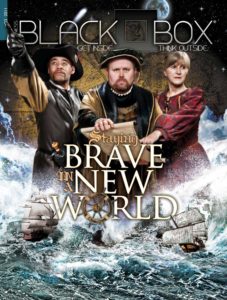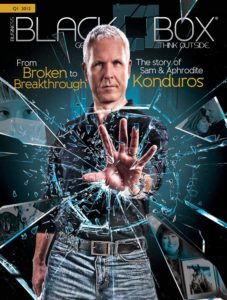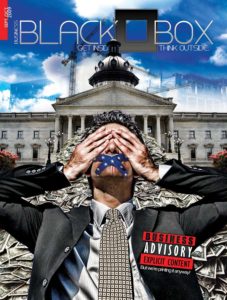
We started up a magazine in the beginning of a recession and turned it into one of the most recognizable publishing brands in the state. There is a lot to be gained from standing apart.

A Fade to Black
Why would a publisher build a successful print publication from the group up — and then close it? … To make way for something better.
By Jordana Megonigal
What is FedEx?
How about Apple?
BMW?
Without thinking about it too much, list three specific things, tangible or not, that you associate with each of these companies.
Your answers — what these entities mean to you and what you have come to expect of them — describe what makes a company a brand.
David Ogilvy, the “father of advertising,” defined brand as “the intangible sum of a product’s attributes.” So a company, like any one of these stalwart, successful ones, is memorable not just because of its product features, but because of a position it holds in consumers’ minds. Done well, the perception is of being unique, of being distinctly and valuably different from companies that produce similar products.
It’s not easy to describe. It’s even harder to do.
Defining Moments
The road to “uniqueness” — or competitive differentiation — is a winding and sometimes rocky one. Before we became The Brand Leader, for example, we were two companies: a marketing agency on one side, and the publisher of regional business magazine Business Black Box on the other. When we launched Black Box in 2008, we wanted to tell the true stories of local businesses in Greenville, South Carolina. And not just about their successes, but their failures. Like the black box in an aircraft, our magazine would provide a true record of what made individual businesses thrive or struggle — and in some cases, fail — in order to help other ones learn and grow.
Our own story is about adaptation and our desire to keep our uniqueness rooted in what we’re good at (understanding how brands tick), our ability to inspire others (to evolve), and our collective desire to enjoy what we do every day (the ideal, right?).
This led us to the difficult decision to shutter Business Black Box in 2017 and turn our focus to helping other companies define, build, and promote their brands. We went all-in with what was at the time our sister company, the branding agency Showcase Marketing. We re-branded ourselves as The Brand Leader.
We drove each major phase of our evolution by periodically stopping to ask ourselves some hard, self-assessing questions. Doing so is essential for all brands. This introspection is a critical opportunity to identify whether or not you have a unique “It factor” — and if you do, is it still working for you? Or is it time to reassess and make some changes?
These are the big questions we asked ourselves as we built a very successful print publication and then closed it for a different destiny. They are the questions we continue to ask both ourselves and our clients.
Question #1: What makes you uniquely valuable?
As Ogilvy pointed out, uniqueness isn’t simply a product of what you do or what you make. It’s the combination of value, visibility, and memorability that sets you apart from everyone else in your space. It translates to the gut feeling people have about your brand when they see your logo, your masthead, or your ads. Think BMW (“The ultimate driving machine”). The more you can identify and tighten your position in a niche, the more success you tend to find. In today’s consumer and media landscapes, it’s the niche brands targeting specific needs and interests that are faring best. As marketers like to say, “The riches are in the niches.”
With Business Black Box, we were unique from the start. At that time, the region’s sole business publication focused on lists of best lawyers, bankers, and top real estate agents. Meanwhile, the actual conversations in the community centered on the knowledge economy, manufacturing (BMW, Michelin, Lockheed, Denny’s, Ryobi, and Bausch + Lomb are all headquartered in upstate South Carolina), biomedicine, robotics, and innovation capital. We were the one publication addressing these topics and the related culture, diversity, innovation, and entrepreneurship that was changing the region’s economic landscape. We tackled the issues relevant to the “next generation” in the business world.
The Great Recession of 2008 hit two months after we published our first issue. But, we stood out enough that businesses were willing to invest in our publication despite being in the midst of hard, unpredictable times. They wanted our platform in order to communicate with the business community. And we thrived.
Question #2: How can you leverage your unique identity and then build a brand around it?
Your uniqueness becomes the central idea with which you’re identified, the core narrative that your customers and your market tell about you. It’s how those for whom your product (or service) matters most define and describe you, both factually and emotionally. To achieve a powerful resulting brand, three things need to work in concert and positively reinforce each other: this “narrative,” your identity (the logos and colors and all the rest), and your customers’ actual experience with you and your products or services. In other words, align your culture with your reputation, your behavior with your uniqueness, and your promises with reality.
Since Business Black Box started off focusing on subjects that no one else was covering, we were seen as future-focused and as a valuable resource for the business community — and we ran with it. We were early adopters of social media, which we used to help other businesses understand and utilize the platform.
We held flash networking events, where local businesses could come together in local coffee shops and meet each other with no strings attached. We created engaging, interactive booths at business conferences. We pushed boundaries and bucked trends far more than a typical business magazine would. We even eschewed the standard guy-in-suit photos on our covers and gave our designers creative license with feature designs. (Did you know that it’s possible to rent a buffalo for a photo shoot? Or that your local business leaders might not say no if you ask to dress them up in Renaissance costumes for a story?).
By doing these things that were natural but creative extensions of our mission, we became memorable. People noticed. They began to talk about us every time we hit the newsstand. (“Who the heck thinks to put the city’s economic development director in a period costume?”) And with that buzz came visibility. More and more people heard about us, read the magazine, came to our events, and sought to advertise with us.
Question #3: What is your extrinsic value?
When you buy a MacBook from Apple, you’re getting an exchange of product for money. But, you’re also getting a series of commitments: that the quality will hold up, the color resolution will be the best in the world, and the customer service will always be there when you need it. All of these commitments add value on top of the “cash value” of the product itself.
It’s the same for any other product or service. There is the intrinsic value (what someone will pay to get your product or service) and the extrinsic value (what your commitments “add on” to that value and thus make your product more unique and desirable).
With Black Box, our original, intrinsic value on the sales side was just like that of every other advertising-fueled magazine: You, advertiser, pay us for the advertising space you would like to fill, and we will fill said space with your ad. But the extrinsic value was something else entirely. It was fair game for us to invent.
For example, we asked our advertisers: “If we deliver our magazine to your top 10 potential clients, would that add value to your ad purchase?” The answer was a resounding yes, so we did just that. With little impact to our bottom line (outside of postage) and a small increase to our distribution count, we were able to ensure that a client’s ad was that much closer to reaching the eyes of the people they wanted to have see it most. It was a win-win, and it made us stand out because no one else was doing it.
This question of value proposition also led us to one of the most unique points of difference for Black Box: our successful advertising partnership model.
Something we had that most other magazines didn’t was ready access to an agency (remember our sister company?). Showcase Marketing provided us with research insights about advertising — like how advertisers prefer to purchase ad plans and what they find most valuable in offerings. During the recession, for example, they were very interested in any mode of advertising that enabled them to stand out from their competitors. After studying the research and our market, we made a daring choice. We made our ad package exclusive by industry (i.e., only one law firm could advertise at any given time). On top of that, we put one firm, non-negotiable price tag on it. Sure, the intrinsic value was directly linked to the actual product, but the extrinsic value was one no other publication offered: the opportunity for a company to get in front of 10,000 business owners without any competitors present to vie for attention.
It was a bold move, and one that might not have worked — but it did. The model became well-known not just locally but nationally. Our partners signed up for packages that included print and online ads, social media promotion, and event sponsorships — and they stayed on for years. And get this: We had waiting lists of eager advertisers in multiple categories (imagine?). The exclusivity enabled our advertisers to gain traction against their competitors. We proved that a brand’s unique value proposition — when truly valuable — translates to revenue opportunities.
Question #4: Would the market miss you if you disappeared? What makes you irreplaceable?
The brands that are strongest are those that are different in ways that are important to their customers. This is when differentiation equals value. Once a brand is valuable to its core audience, it becomes hard, if not impossible, to replace.
Each time we went through this self-assessment process at Business Black Box, this question was the hardest one to answer. The truth was, while we thought the market would miss us if we left (and that turned out to be true), the reality was that by 2016 there were four business-focused publications in our market. Each of these had its own stream of networking or business-focused events. Each one was doing supplemental publications. Each one was (finally) focusing on our knowledge economy. The uniqueness we started out with — being the future-focused publication — had been capitalized on by three other publishing brands.
At the same time, we began to see more companies that wanted to do what we had done with Black Box. They wanted magazines that could tell their own stories, and they saw us as leaders who could help them do it.
This jived with the essence of what we first set out to do — help business owners thrive in the face of threats and opportunities — so we came to the table alongside these companies more and more often. We enabled them to start their own publications and better define their brands. It was natural for us.
We began to realize that what the market would miss if we were gone was not our magazine. The market would miss our ability to understand and inspire brands — and our ability to help them tell their own stories more effectively.
Question #5: And finally, if you make some hard decisions and changes, what resistance and barriers might you face along the way?
Hard decisions are the junctures where leaders are made and growth happens. Sure, you can avoid them, but you risk becoming stagnant or, worse, boring.
With Business Black Box, we had a number of points of choice — times when we were ready to throw in the towel, times when we were ready to take on the world with a pair of safety scissors, and everything in between. But our discussions in 2017 led to our most difficult decision. We spent over 100 hours across four months processing these questions and playing out every possible scenario for moving forward. When we made our final decision to close the magazine and put all our efforts into the agency side of our business, we prepared ourselves for the necessary conversations with our readers, advertisers, and staff. In our case, the barriers to change were surmountable. Our audience was disappointed, as evidenced by the emails and comments triggered by our announcement. Our advertisers, too, were disappointed, but we renegotiated their contracts and some became clients of The Brand Leader. We encountered the most resistance with our staff. They had put their blood, sweat, and tears into this publication, and it was hard to say goodbye. We waited until we were firm in our decision before telling them so as not to be swayed by any emotional responses. The fact that we encountered relatively little resistance to our decision reinforced that we were making the right one. (Drop me an email, and I’ll send you our recommended process, and accompanying worksheet, for breaking through barriers, both small and large.)
This is our story. What’s your story? Is it time for you to ask these questions of your own brand? Are you stagnating? Have you lost sight of whether you’re offering something unique within your market segment? Would your audience miss you if you were gone? … Do you know?
An honest, periodic brand evaluation is something that we at The Brand Leader recommend for any business and any publication. It’s by asking these tough questions — again and again — that you can keep tabs on your unique factor and gauge whether it’s providing value to your audience and paying dividends for your enterprise.
Yes, it requires a bit of bravery and a lot of tenacity to be this honest with yourself and your team. But it is our hope that you will discover what we did all those years ago, as we started up a magazine in the beginning of a recession and turned it into one of the most recognizable publishing brands in the state: There is a lot to be gained from standing apart.
Jordana Megonigal was publisher of Business Black Box for 10 years and is now director of publishing for The Brand Leader, where she helps clients foray into the world of publishing. Connect via megonigal@pagesthemagazine.com.




